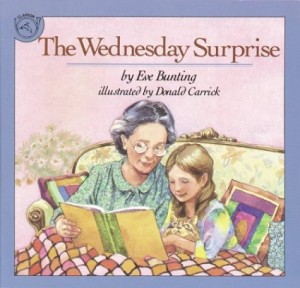One Story to Engage ELL Families: The Wednesday Surprise
 Last week, we featured Roxana Barillas, Director of Hispanic Engagement at First Book. She shared her thoughts on the ways educators can connect with ELL families. This week, Roxana shares one book from Build Strong Families With Stories that can help in engaging ELL families in their child’s learning.
Last week, we featured Roxana Barillas, Director of Hispanic Engagement at First Book. She shared her thoughts on the ways educators can connect with ELL families. This week, Roxana shares one book from Build Strong Families With Stories that can help in engaging ELL families in their child’s learning.
One book in particular that resonated with me was The Wednesday Surprise by Eve Bunting, a book included in the Creating Routines and Traditions section of Build Strong Families With Stories.
From a cross-cultural perspective, I wondered how ELLs would respond to the conversation about these various family strengths, like “creating routines,” and apply that question to their family lives. The question of creating or maintaining traditions and routines in the midst of a different culture is central to ELLs’ experiences and can be a tricky issue for them to navigate.
The story includes a surprise as well as family celebration, and as the related reading guide suggests, celebrations encourage closeness that help a family grow stronger together.
 The family featured in The Wednesday Surprise could be an immigrant family, but is not necessarily one. Even so, there are many aspects of the situation that may resonate with ELLs. For example, the family has limited resources, and many ELL families will recognize the small details that make a child feel special, like a pebble the dad brings home. In addition, the dad is frequently away from home because of his job, and when the mom needs to work late, Grandma takes the bus to visit and spend time with her grandchildren.
The family featured in The Wednesday Surprise could be an immigrant family, but is not necessarily one. Even so, there are many aspects of the situation that may resonate with ELLs. For example, the family has limited resources, and many ELL families will recognize the small details that make a child feel special, like a pebble the dad brings home. In addition, the dad is frequently away from home because of his job, and when the mom needs to work late, Grandma takes the bus to visit and spend time with her grandchildren.
At the same time, the book also offers amazing conversational opportunities with ELLs and their families because it includes routines and traditions that are part of the American experience, like going to the Y for baseball practice and having pot roast on a special occasion, while opening a conversation about how ELLs celebrate holidays and recognize milestones in ways that may be different from the custom of their adopted countries.
As ELLs get older, some of those family traditions become cherished memories, but like most children, ELLs also want to experience the mainstream. They seek affirmation and acceptance, and many find themselves wanting to do things they read and hear about from their classmates that are not part of their home culture. Perhaps they want to go trick-or-treating, go to a friend’s birthday party or have a sleep over. The questions prompted by The Wednesday Surprise can offer cultural nuances that open doors of understanding, perhaps in unexpected ways. These questions can help build a bridge for the delicate dance ELLs navigate between the home and school cultures, as well as expectations of them.
What I love about this book is that Anna, the child and one of the two main characters in this story, manages to do what many ELLs do: she manages to teach the adults a surprising and unexpected lesson by teaching her grandmother to read and giving her dad a gift to remember. She also takes on some new responsibilities, something very familiar to ELLs, by bringing the gift of reading home to her family – an interesting twist when you think about kids who may not be growing up in a home where reading is part of the regular routine.
